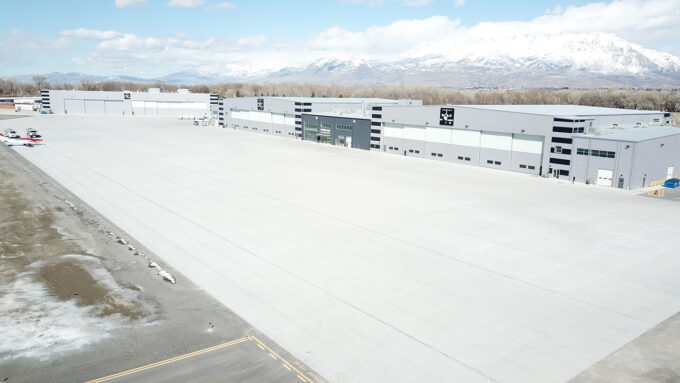Interest in sustainable aviation fuels has grown among business aircraft operators looking to minimize their carbon footprint. But there are many other things business aviation companies can do to ensure they are reducing the environmental impact of their operations. Pursuing such “green” initiatives has become increasingly important to do, as the impetus for business aviation to operate in a sustainable way accelerates.
“Business aviation has long been committed to the sustainability of flight,” says NBAA President and CEO Ed Bolen. “As we continue working toward increased availability of sustainable fuels, we know that these initiatives are key to moving the industry toward a carbon-neutral future in the years to come.”
Maximizing Recycling
Examples of how some NBAA member companies are building greener facilities and operating in more environmentally friendly ways abound. One of the companies that has been dedicated to reducing its carbon footprint is Duncan Aviation, which has had a “Green Team” in place for about 10 years.
Duncan Aviation Provo COO Bill Prochazka said that at the company’s Lincoln, NE, headquarters alone, Duncan has recycled more than a half million pounds of cardboard; 750,000 pounds of various plastics, papers and metals; and 50 tons of batteries.
“All of the above would have gone to a landfill without these programs,” said Prochazka. “Our Green Team is constantly looking for greener products to incorporate into our services, as well as more environmentally friendly ways to perform our work.”
“Our Green Team is constantly looking for greener products to incorporate into our services, as well as more environmentally friendly ways to perform our work.”
Bill Prochazka COO, Duncan Aviation Provo
Prochazka explained that Duncan Aviation Provo’s paint facility “is the closest to thing to a truly green business-jet paint process that you will likely find anywhere on the planet.”
He describes how all the air that passes through the bays is cleaned by an oxidizer to remove 98% of the volatile organic compounds (VOCs) and hazardous air pollutants before discharging the air back into the environment. Also, all process water is captured and separated from the solids, which are sent to a federally licensed disposal facility.
“We used to have to haul off dozens of barrels [of solids] from a single aircraft operation to a disposal site,” explained Prochazka. “Now, two or three barrels will hold the solids from over a dozen aircraft.”

Duncan Aviation's Provo, UT paint facility features an oxidizer that removes 98% of hazardous air pollutants.
A Greener FBO
Another example of a business aviation operation working to be greener is Gary Jet Center (GJC) at Gary/Chicago International Airport (KGYY) in Gary, IN.
GJC President Lynn Eplawy explained that the FBO’s Hangar III was the first building in Gary certified to Leadership in Energy and Environmental Design (LEED) standards, achieving U.S. Green Building Council (USGBC) Gold certification. Eplawy said that the hangar was the result of some “ethical decisions” made during planning and construction by LEE Construction.
“We were fortunate that our construction company was interested in joining the [environmentally friendly] efforts, so the decisions to go toward LEED standards were made from the very beginning,” Eplawy said. “They agreed to present solutions throughout the process to ensure we were building with LEED standards in mind.
“Our ultimate goal was to be a good steward of our environment – to be a great citizen,” continued Eplawy. “We didn’t choose to build to LEED standards because it was the least expensive way to build, or because it was going to attract more business. We took it as something we could do to make an environmental impact and be a standard for green building in the aviation industry.”
The 40,000-square-foot Hangar III was built in 2012 with a 28-foot-high door so it could accommodate any size business aircraft. Eplawy says that LEED certification took nothing away from the hangar’s functionality; it only enhanced it. The hangar complements GJC’s LEED Silver-certified 8,300 square-foot FBO and flight center built in 2017.
“Our business is based in Steel City USA, and being in the nation’s Rust Belt challenges the perception of your business from others outside of here,” Eplawy said. “Gary and Chicago were built as industrial towns, but we’re so much more than that. We’re minutes from magnificent Lake Michigan, and Indiana Dunes National Park is just a few miles away, which remind us of the wonders of nature around us. As a business, we wanted to … ensure what we did mattered to these environmental gems in our backyard, and building with a green strategy was simply the right thing to do.”
Many Ways to Pitch In
While it is easy to think of going green strictly in construction terms, there are a large number of other things that business aviation companies are doing to reduce their carbon footprint. In fact, it is hard to find any element of an operation that cannot be modified in some way to make it more environmentally friendly. For example:
- Countertops and furniture can be made from sustainable materials.
- Support equipment, crew cars and company vehicles can be all-electric.
- Drought-tolerant and native plants that require little or no irrigation can be planted.
- Low-flow plumbing and motion-detecting interior LED lighting can be installed.
- Paper towels can be replaced with hand dryers.
- Excess rainwater can be collected and re-used for aircraft cleaning and other purposes.
- To reduce overall energy consumption, high-efficiency heating, ventilation and air-conditioning units can be used; thermal insulation can be increased; and low-VOC white paints can be used to reflect available light from larger windows.
In the case of Hangar 25 at Bob Hope International Airport in Burbank, CA – which became the world’s first LEED Platinum-certified aviation facility in 2008 – more than 1,500 solar panels installed on the roof provide 110% of the hangar’s electricity, while feeding an electric plug-in system to power aircraft during maintenance.
Duncan Aviation’s Prochazka summed up why business aviation should stay focused on keeping its facilities as green as possible:
“When it comes to Mother Earth, we should always be doing the right thing to protect her. The primary benefit of our green initiatives is to be able to look the next generation squarely in the eye, knowing that we are doing everything we can to be good stewards of the planet.”
Review NBAA’s environmental resources at nbaa.org/environment.
The Benefits of Green Construction
The term “LEED” (Leadership in Energy and Environmental Design) comes from the U.S. Green Building Council (USGBC), which has developed a third-party scoring system to apply to new construction and facility retrofits. The LEED program provides building owners and architects a means for implementing measurable green building designs.
Globally, LEED is currently used in 167 countries and territories with demand growing, as experts predict that global green building will double every three years. In 2018, the USGBC reported more than 52,400 registered projects totaling nearly 33.5 billion square feet, with more than 2.2 million square feet of space achieving LEED certification every day.
Meeting LEED standards is not just about being environmentally friendly; when the LEED framework is followed, owners can see substantial long-term savings. Between 2015 and 2018, the USGBC estimates that LEED construction has resulted in:
- $1.2 billion in energy savings
- $149.5 million in water savings
- $715.3 million in maintenance savings
- $54.2 million in waste savings

Gary Jet Center's Hangar III is LEED Gold Certified, using one-third less energy than the average hangar.
Textron Aviation Harnessing Kansas Wind Power
Textron Aviation has signed an agreement with Evergy Inc. to meet nearly all of its electricity needs at the company’s facilities located in Wichita and Independence, KS, by utilizing renewable wind energy.
Evergy, a Kansas-based utility, will provide Textron Aviation’s Kansas facilities with 55 megawatts of energy from a wind farm that is being constructed near Manhattan, KS. The OEM uses enough energy to power about 22,500 homes. By supporting wind energy production in Kansas, Textron Aviation will significantly offset its carbon footprint.
“The purchase of renewable energy demonstrates our commitment to a more sustainable future for our employees, communities and customers,” said Brad White, Textron Aviation’s senior vice president of operations.



 International Business Aviation Council Ltd.
International Business Aviation Council Ltd.